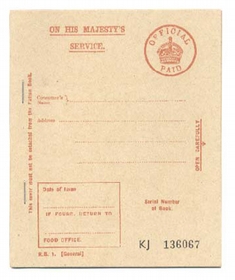1940s Mining Life
World War II ration book
© National Coal Mining Museum for England (Photo: National Coal Mining Museum for England)
© National Coal Mining Museum for England (Photo: National Coal Mining Museum for England)
In 1940, because of the war, the Government started rationing. Each person had a ration book and used it with their identity card to receive food. If they did not have the ration book, they would not get any rationed food.
When food ration books were issued, each one had to be registered with a particular shopkeeper. The first rationed foods were sugar, butter, lard, bacon, and meat. There was rigid price control for such items. The size of the weekly ration varied from time to time, becoming smaller as the war went on. There were seasonal increases in sugar so that jams and jellies could be made, to avoid wastage of seasonal fruit.
There were no supermarkets in pre-war England. Routine shopping entailed visits to the butcher, the grocer, the greengrocer, the fishmonger, the ironmonger (hardware store) and the sweet store. The latter was often combined with the tobacconist. Bread and milk were still delivered, but most other deliveries became a thing of the past. English housewives carried large shopping baskets and cloth or string bags for their purchases.
It was important to be friendly with the shopkeepers, as they sometimes received rare unrationed goodies. These included biscuits, especially chocolate ones, soap flakes, canned meats (later to be rationed), cigarettes, and sweets (also rationed later).
When food ration books were issued, each one had to be registered with a particular shopkeeper. The first rationed foods were sugar, butter, lard, bacon, and meat. There was rigid price control for such items. The size of the weekly ration varied from time to time, becoming smaller as the war went on. There were seasonal increases in sugar so that jams and jellies could be made, to avoid wastage of seasonal fruit.
There were no supermarkets in pre-war England. Routine shopping entailed visits to the butcher, the grocer, the greengrocer, the fishmonger, the ironmonger (hardware store) and the sweet store. The latter was often combined with the tobacconist. Bread and milk were still delivered, but most other deliveries became a thing of the past. English housewives carried large shopping baskets and cloth or string bags for their purchases.
It was important to be friendly with the shopkeepers, as they sometimes received rare unrationed goodies. These included biscuits, especially chocolate ones, soap flakes, canned meats (later to be rationed), cigarettes, and sweets (also rationed later).


